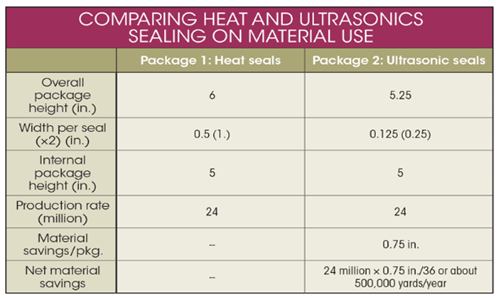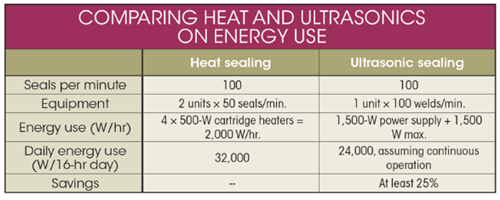
Ultrasonic In the Road of Packaging 2
Ultrasonic In the Road of Packaging 2
Ultrasonic Advantages
Packaging engineers considering ultrasonic welding as an alternative to heat sealing are often driven by a variety of factors. These include:
• Eliminating seal failures due to contamination. Some products leave residues on sealing surfaces that can become encapsulated within conventional, static conduction heat seals, resulting in contamination, leaks, or failures. These include many food and beverage products, leafy produce, and powders, as well as feeds, viscous liquids, and oils and greases.
The vibratory motion of ultrasonic welding not only heats the sealing surfaces, it also first vibrates potential contaminants out of the seal area. For example, with thermal seals, product particles can get caught on sealing surfaces, potentially compromising them. With ultrasonic, the vibratory action and pressure not only cuts through any large pieces of a product (e.g., produce leaves), but also disperses smaller fragments and moisture out of the seal areal. This improves seal repeatability and reliability.
• Reducing material consumption and cost. A snack food packager making snack bags (6-in. size) consumes about 1 in. of total package length to produce two conventional heat seals per bag (0.5 in. each on top and bottom). Two comparable ultrasonic welds require just 0.25 in. of total package length (0.125 in. each on top and bottom), resulting in a savings of 0.75 in. (0.375 in. × 2) in material per bag with the same net product volume.

• Increasing sealing process speed/cycle rates. Ultrasonic seals can be completed in as little as 150/msec, so cycle times for ultrasonic sealing typically do not present a bottleneck to increasing overall package cycle rates. No cooling time is required either, so sealing rates of up to 110 packages/min. are possible. By contrast, heat-seal cycles must not only complete the heat seal, but also give the melted plastic a brief cooling/set-up period to solidify, making them significantly longer.
• Need to handle temperature-sensitive products. For heat-sensitive or potentially flammable products, including spirits and lubricants, the high external temperatures and longer cycle times involved with heat-seal bars can pose a risk of exceeding the product’s flashpoint. This problem is eliminated with ultrasonic. Similarly for heat-sensitive electronics, ultrasonic welds create strong, repeatable seals in a fraction of a second, with the heat energy constrained to the interior surfaces of the packaging material and away from the electronics.
• Reducing changeover times and improving process flexibility. If packaging demands can shift rapidly, ultrasonic welding equipment lends itself to rapid changes in production because tooling is always “cold.” When needed, operators need only swap out the converter, horn, and anvil/fixture to suit the new production requirements; input the proper process parameters to weld controls; and resume production. In contrast, conduction heat sealing equipment needs a cool-down period before the heat bars can be safely handled. Following changeover, they need a warm-up period to bring the new heat bars to proper sealing temperatures.
• Reducing energy costs. Conduction heat-sealing systems must be continually powered and maintained at a precise operating temperature, so they consume relatively high amounts of energy. For example, consider a packaging line producing 100 welds/minute over two eight-hour shifts per day. A typical conduction sealing process would require four 500-W cartridge heaters (2,000 W/hr or 32,000 W/day) to continuously maintain seal-bar temperatures.

© Copyright: 2025 Hangzhou Altrasonic Technology Co.,Ltd All Rights Reserved

IPv6 network supported
Scan to WhatsApp
